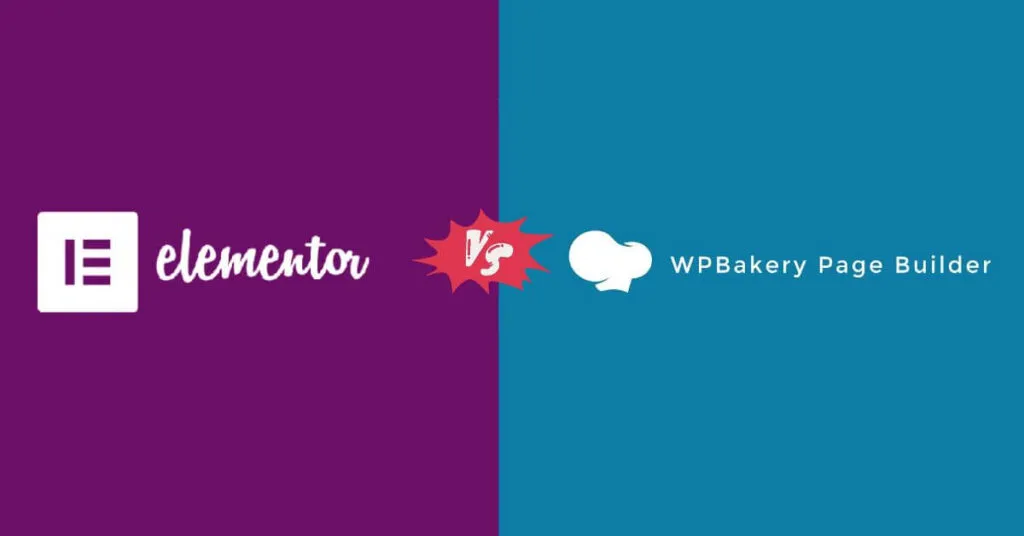Elementor VS WPBakery – Several years ago, someone without coding skills would have had to rely entirely on a web designer or developer to launch a basic landing or sales page for their business. Not only was it difficult to train or hire an expert to do this, but it often took much more time than anyone would be willing to admit.
With the advent of Visual Page Builders, the process of creating web pages became much faster and simpler, especially for those who didn’t want to deal with static HTML.
Even better is the advent of WordPress website builders, which have made web page design a much more visual process. In fact, one study found that if you only consider websites built with a CMS, 60% of those sites are built using WordPress.
Now, web designers and engineers can design and implement more websites in a fraction of the time. Additionally, newbies and startups can avoid recruiting and employing large teams of web designers or developers and save resources and time that would otherwise be spent on web development.
There are several WordPress page builder options available, two of the most popular ones regularly used by WordPress development professionals are Elementor and WPBakery, which we will be pitting against each other in this comparison review.
Before we start comparing WPBakery vs Elementor, let’s see what they are.
Elementor VS WPBakery: Introduction
An Introduction to Elementor
Elementor is a WordPress page builder that helps you build, design, and develop beautiful websites quickly and easily.
If you’re looking for an easy drag-and-drop page builder, Elementor is worth exploring as it lets you drag and drop objects, edit live, and displays your changes in real-time.
The difference that Elementor offers is that it allows you to achieve a high degree of design when creating your web pages live and on the front end of its platform.
This way, you will have endless opportunities to build your website or pages and enjoy a variety of features, including a prototype library, widgets, and visual revision history applications.
Since 2016, Elementor has been steadily developing to have thousands of active installations, making it one of the most successful WordPress page builders on the market. Because of its convenient and flawless visual component, complete theme designing and customization options, among many other advanced features, it has managed to achieve such development.
Elementor started out as a basic page editor, but has since evolved, and now Elementor Pro, its advanced edition, is equipped with many more features that go beyond page development.
Some features of the Pro edition also include Theme Builder and Popup Builder, all of which provide the functionality you need to create entire theme and popups using the Elementor interface.
Elementor Page Creator removes the simple WordPress editor so you can visually create dynamic templates and design the web live without switching between editing and preview modes.
The interface is user-friendly and the page builder is continually updated to make it streamlined and fast. You don’t have to struggle with any waiting times this way because it happens instantly.
An Introduction to WPBakery
WPBakery is a WordPress page builder plugin that provides a fast drag-and-drop engine for generating stunning website content. This page builder allows you to design, develop, and maintain content on your WordPress platform in minutes without coding.
WPBakery is a special plugin that helps you create your layout easily and quickly, without becoming an HTML wizard or wasting time writing shortcodes.
Elementor vs WPBakery: Features
Elementor Features
- Drag and drop editor:
Elementor’s drag-and-drop editor is fast and intuitive, so you can move and configure items on your pages or website to your liking without wasting time.
- Designer models:
If you are not sure how your website should look, Elementor offers 300+ beautifully crafted templates for any use or business to help you choose and customize your website.
- Widgets:
Elementor offers 90+ widgets for content creation, including titles, icons, shapes, and more.
- Responsive Editing:
If you want to view web pages on your tablet or laptop, Elementor has responsive editing that lets you adjust each object to make it look fantastic on all devices.
- Theme Builder:
Do you need to edit every section of your website without the need for code? Elementor Theme Designer will help you with all of that.
- Browser:
In Elementor, the Navigator feature helps you to navigate within and between web elements or layers, and easily examine and display custom modifications through indicators.
- Editing tools:
Elementor provides many editing features, some of which are present in word processing applications, such as redo/undo, to help you undo mistakes or redo an activity with a basic keyboard shortcut or button.
It also provides a quick cheat sheet, autosave, revision history, draft mode, copy and paste, copy style, inline editing, universal widget, and dark mode that lets you create darker setups while saving power.
- Background resources:
Elementor provides background gradients to apply gradient colors to your pages or blogs. It also allows you to add background videos and overlays with colors, images, or gradients.
You can also set device-sensitive background images and set custom scaling and positioning for each device. You can also create slideshows as backgrounds for columns or pages on your blog.
- Layout tools:
Elementor plays a big role in how your website and websites look, which is why it offers a lot of styling options. This involves segment width and height, column gap, total and column width, text positioning, padding, and margins. To place any widget, row, or column in front and behind, a z-index is used.
Inline components, flexbox orientation (vertical and horizontal), fixed positioning, and nesting columns are other layout tools.
WPBakery Features
- Editor:
WPBakery lets you save time with its simple front-end and premium back-end editor and drag-and-drop page builder features. It’s the most feature-rich page builder with both regular plugins and premium-level features that you can use to build pages, blogs, portfolios, or portals without coding.
The responsive built-in editor lets you see improvements immediately, while the backend editor helps you create your custom pages, blogs, and post styles that can be displayed in schematic mode.
- Template and Presets Library:
WPBakery even has a dedicated collection of professionally designed mockup templates. You’ll get a variety of mockups and can download any template you choose to use on your website in seconds. There are style templates and over 100 pre-designed designs. You can also create default element settings by adjusting the content element settings or selecting the default settings so you don’t have to change them constantly.
- Content elements:
There are over 50 pre-packaged content components that you can use to create posts and pages by dragging and dropping objects onto your site. These include text blocks and buttons, post grids, and accordions, among others.
- Complements:
WPBakery provides 250+ unique add-ons that will enhance your page building capabilities with rich element packs and innovative WordPress features.
- Design options:
If you need different skins for your website, you can use WPBakery design software and adjust the colors and padding to adapt the website to your company brand.
- Diagrams:
WPBakery provides unlimited website templates and the right tools to make blogging and website creation simple and easy. You can use this feature-rich builder to add your imagination to your WordPress account.
Elementor Vs WPBakery: Pricing
Note: Prices are subject to change
Elementor Pricing
Elementor offers four pricing plans: Free for any number of pages, Personal ($59) per year for one site, Plus ($99) for 3 sites, Expert ($199) for 25 sites and Agency ($399) for 1000 sites.
WPBakery Pricing
WPBakery only offers three pricing plans: Basic at $69 for single-site use and provides additional support and access to the design repository, Expanded at $256 for 5 sites and $499 for 10 Sites SaaS use with theme compatibility, advanced support, and free updates.
WPBakery offers bulk licensing discounts starting at 20+ licenses, and you can test the plugin for free by going to the demo site and making your own sandbox demo.
Elementor Vs WPBakery: Pros and Cons
Elementor Pros and Cons
Pros:
- Free plan available
- open code
- Great user interface
- Multiple integrations
- Feature rich
- Extreme customization
- Updated regularly
- Instant test
- Easy to use
- Works with all themes
- Intuitive drag/drop editor
Cons:
- No white label version
- Some users complain about support
- No lifetime option
WPBakery Pros and Cons
Pros:
- Affordable prices
- Function access control
- Multilingual support
- Variety of content blocks
- Pre-made templates can be saved for later
- Works with many themes
- Various add-ons
Cons:
- It has a learning curve
- There are not so many elements available
- It is not simple in its use
- Shortcode based
- It can be expensive for customers
- Free trial available in demo sandbox only
Read Also:- 10 Best WordPress Magazine Themes 2024
Elementor Vs WPBakery: Which is Better?
We hope you now know the main differences and parallels between Elementor and WPBakery.
WPBakery is very restrictive in terms of functionality and does not offer a free plan as such, so you would have to build your own sandbox demo and test it out for free.
Also, it is shortcode oriented and many people would not want to go that route.
We suggest using Elementor for this roundup. Not only is it available for free, but it’s packed with great features for content creation, architecture, media, marketing, writing, social media, and more.
Elementor would give you the best value for your money, plus an engaging online community for further support or networking.

Lokesh Sharma is a digital marketer and SEO expert at TechJustify with a keen interest in emerging technology trends including AI, cybersecurity, and digital marketing tools for more than 5 years. He writes clear, actionable articles for tech enthusiasts and business leaders, simplifying complex topics like VPNs, automation, and generative AI.




